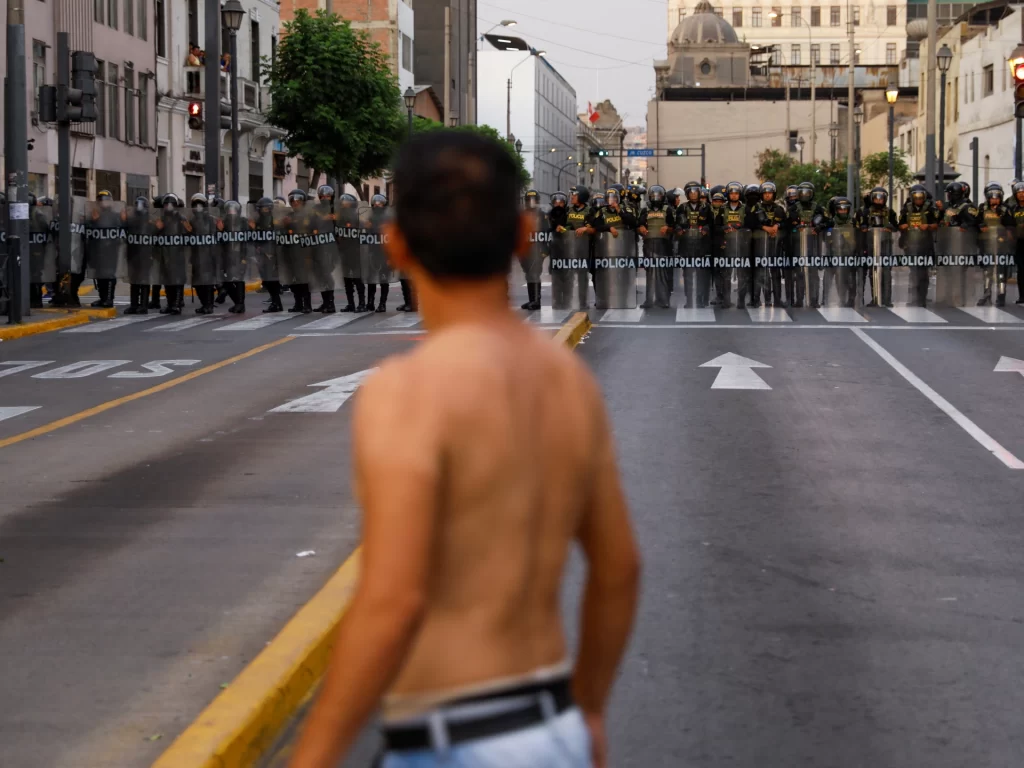The Peruvian government was more likely to use lethal violence in marginalised areas of the country as part of its crackdown on recent anti-government protests, a report by rights group Amnesty International has found.
Thursday’s report, “Lethal racism”, alleges the government’s actions may constitute extrajudicial executions in some cases. Amnesty calls for the Peruvian Attorney General’s Office to investigate the use of excessive force in response to the protests.
“Using lethal firearms against protesters shows a blatant disregard for human life,” Agnes Callamard, Amnesty’s secretary general, said in a press release.
“Despite the government’s efforts to paint them as terrorists or criminals, those killed were demonstrators, observers and bystanders. Almost all of them were from poor, Indigenous and campesino backgrounds, suggesting a racial and socioeconomic bias in the use of lethal force.”
The report is the latest to find that Peru’s government wielded disproportionate violence and targeted people from poor and Indigenous backgrounds during the protests that enveloped the country following the ouster of former President Pedro Castillo.
Boluarte faces criticism
The crisis began on December 7, when Castillo faced his third impeachment hearing.
Rather than face an opposition-led Congress, Castillo attempted to dissolve Peru’s legislature and rule by decree, a move widely considered illegal. He was quickly impeached, removed from office and arrested. Meanwhile, his former vice president, Dina Boluarte, was sworn in as Peru’s first female president.
Castillo’s supporters, many of them from poor and rural areas seen as neglected by the state, took to the streets to protest his detention. Among their demands were calls for a new constitution and elections.
Boluarte’s administration has since been criticised for its heavy-handed response to protests and failure to address popular discontent. The Amnesty report found that, between December and February, 49 protesters were killed.
The government’s response has also heightened tensions between Peru and other countries in the region, especially those with left-leaning leaders who were friendly with Castillo.
Peruvian authorities on Thursday declared Mexican President Andres Manuel Lopez Obrador a persona non grata after months of him criticising Boluarte as a “puppet”. He had also offered Castillo and his family asylum in Mexico.
Lopez Obrador became the latest major Latin American leader to be slapped with the label after Colombian President Gustavo Petro and former Bolivian President Evo Morales.
https://imasdk.googleapis.com/js/core/bridge3.578.0_en.html#goog_1556629250Play Video
Video Duration 02 minutes 55 seconds02:55Peru: Indigenous communities call for Boluarte resignation
‘Language of terrorism’
Amnesty’s report analysed 52 documented cases of people killed or wounded in areas such as Ayacucho, Juliaca, Andahuaylas and Chincheros, including 25 deaths.
The organisation concluded that 20 of those 25 slayings could constitute extrajudicial executions. They involved cases where security forces used live fire on crowds and aimed at vulnerable parts of the body such as the head, neck and abdomen.
When faced with criticism and calls for accountability, Peruvian authorities have often framed protesters as agitators looking to create disorder.
“We took over a polarised country, a country in conflict, a country with extremist sectors that seek to generate disorder and chaos, with their own agenda, to destroy our institutions and democracy,” Boluarte said in a January address.
“Are we perhaps returning to the years of terrorist violence, during which dogs were hung from lampposts?”
Will Freeman, a fellow for Latin American studies at the Council on Foreign Relations (CFR), a United States think tank, told Al Jazeera that such rhetoric taps into collective memories from a period of civil conflict that roiled Peru in the 1980s and 1990s.
During that time, armed groups such as the Maoist Shining Path attempted to overthrow the government and carried out violent campaigns targeting civilians, including Indigenous people.
In response, the government initiated a brutal counterinsurgency effort that also included widespread abuses.
“Politicians are trying to invoke that history of the Shining Path to draw parallels with the current protesters, but that is wrong and insulting,” Freeman said in a phone call. “It’s weaponising the language of terrorism to scare people.”

Anti-Indigenous violence
Amnesty’s report states that authorities were more likely to use lethal violence in regions with large Indigenous populations such as Ayacucho, even if the protest activities were similar in frequency and intensity to other areas.
“This report’s findings are only the tip of the iceberg in a painful history of discrimination and exclusion for Peru’s indigenous peoples,” Erika Guevara-Rosas, Amnesty’s Americas director, told Al Jazeera via email.
She added that family members of victims who spoke with Amnesty described “humiliating treatment” in “hospitals or public offices, with insults alluding to their ethnic identity”.
https://imasdk.googleapis.com/js/core/bridge3.578.0_en.html#goog_488372276Play Video
Video Duration 01 minutes 58 seconds01:58Amnesty investigates 46 cases of violations during Peru protests
In January, Peru’s attorney general launched a series of inquiries to identify those responsible for dozens of mostly civilian deaths during the unrest, but Guevara-Rose said that accountability remains distant.
“Authorities have not achieved any significant accountability for the crimes committed by police and military in recent months,” she said.
“Basic steps need to be taken urgently including interviewing police and military officers urgently, carrying out remaining forensic investigations, as well as ensuring investigations take place on the ground and close to victims.”
Source: Al Jazeera

